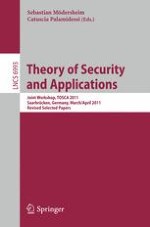This book constitutes the thoroughly refereed post-conference proceedings of the Joint Workshop on Theory of Security and Applications (formely known as ARSPA-WITS), TOSCA 2011, held in Saarbrücken, Germany, in March/April 2011, in association with ETAPS 2011. The 9 revised full papers presented together with 3 invited talks were carefully reviewed and selected from 24 submissions. The papers feature topics including various methods in computer security, including the formal specification, analysis and design of security protocols and their applications, the formal definition of various aspects of security such as access control mechanisms, mobile code security and denial-of-service attacks, and the modeling of information flow and its application.
